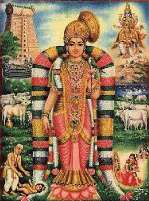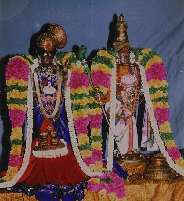| You are here: Sri Vaishnava > Alvars > Andal | Add/View Comments |
 ANDAL
ANDAL

The remarkable girl who would marry none but the Lord
Andal is one of the most extraordinary personalities
in religious history. She is known
in her native tongue of Tamil as an Alvar, one who
is "immersed" in the depths of enjoyment of God, the
 omnipresent mysterious One. Tradition reckons
12 Alvars,
of which Andal is the only female. Between the fifth and
ninth centuries, in the Tamil-speaking region of South India,
these saints revitalized the Indian religious milieu,
sparking a renewal of devotional worship throughout
the subcontinent. Traveling from place to place,
from temple to temple, from holy site to holy site, they
composed exceedingly beautiful poetry to their Divine
Beloved, Vishnu, as an expression of their love for
Him. Anyone can see why their poetry was so attractive;
at once both impassioned and philosophical, their words cut
across all barriers of caste and class, attracting all
to their faith. In doing so, they sculpted a new
religious heritage of intensely emotional bhakti, or
love of the Divine, whose impact is still felt today in the
Indian religious life. Andal, whose
life and poetry are celebrated every December-January, is the
most visible contributor to this heritage.
omnipresent mysterious One. Tradition reckons
12 Alvars,
of which Andal is the only female. Between the fifth and
ninth centuries, in the Tamil-speaking region of South India,
these saints revitalized the Indian religious milieu,
sparking a renewal of devotional worship throughout
the subcontinent. Traveling from place to place,
from temple to temple, from holy site to holy site, they
composed exceedingly beautiful poetry to their Divine
Beloved, Vishnu, as an expression of their love for
Him. Anyone can see why their poetry was so attractive;
at once both impassioned and philosophical, their words cut
across all barriers of caste and class, attracting all
to their faith. In doing so, they sculpted a new
religious heritage of intensely emotional bhakti, or
love of the Divine, whose impact is still felt today in the
Indian religious life. Andal, whose
life and poetry are celebrated every December-January, is the
most visible contributor to this heritage.
[ Biography -
Further Thoughts -
Tiruppavai ]
Life of Andal
The life of Andal is remarkable in its romantic simplicity. A devout brahmin named Vishnucitta lived in Villiputtur, a town near Madurai. His daily duties included procuring
 |
|
Vishnucitta discovering Andal. Scultpure above the tulasi garden in Srivilliputtur |
Godai grew up in an atmosphere of love and devotion. Vishnucitta doted on her in every respect, singing songs to her about his Beloved Krishna, teaching her all the stories and philosophy he knew, and sharing with her his love of Tamil poetry. The love Vishnucitta had for his Beloved Lord intensified further in his daughter, and before long she was passionately in love with Lord Krishna. Even as a child, Godai made up her mind to marry none but the Lord of Brindavana, and refused to think of any human being in similar terms.
She imagined what it would be like to be His bride, playing the role of His beloved, enjoying His presence. Unknown to her father, she adorned herself daily with the flower garland he prepared for the Lord at the temple. After admiring her reflection and thinking of herself as His ideal bride, she would put the garland back for her father to take to the temple and offer to the Lord.

|
| Traditional Painting of Andal |
One day, Vishnucitta noticed a strand of Godai's hair on one of the garlands. Shocked and saddened by this desecration of what was meant only for the Lord, he scolded Godai for her misuse of the garland and discarded it. He carefully prepared a new one and offered it to the Lord, begging His pardon all the while.
That night, the Lord appeared to Vishnucitta in his dream and asked him why he discarded Godai's garland instead of offering it to Him. He told Vishnucitta that He missed the scent of Godai's body in the flowers, and that He preferred them that way. Would he please continue to give the garlands once worn by Godai? Overcome with emotion, Vishnucitta awoke and cried tears of both joy and remorse. It dawned on him that his daughter was someone whose love of God was so intense and pure that even he had not comprehended its extent. Her spiritual greatness was such that the Lord Himself wished to share her presence. From this day on, she became known as "Andal", the girl who "ruled" over the Lord.
Andal blossomed into a beautiful young woman as she came of marriageable age. When asked to marry, however, she stubbornly refused, saying that she would only agree to marry Sri Ranganatha, the Lord at the great temple town of Srirangam. Vishnucitta despaired, wondering what was to become of his daughter. One night, Lord Ranganatha appeared in his dream and asked that Andal be sent to Him in all her wedding finery. Simultaneously, the Lord appeared before the priests at Srirangam and asked them to prepare for the coming of Andal. Vishnucitta once again was filled with both joy and sadness; joy that his beloved daughter would attain her goal, but sadness

|
| The Divine Couple: Andal and Rangan
in Srivilliputtur |
Andal waited with excited anticipation as the wedding party approached Lord Ranganatha's shrine. As they entered the temple, she jumped out of the palanquin, unable to restrain herself any longer. Running into the temple sanctum, she embraced Lord Ranganatha and disappeared in a blaze of glory, having joined her Lord. She was only fifteen at the time.
Andal is now one of the best loved poet-saints of the Tamils. Pious tradition reckons her to be the veritable descent of Bhumi Devi (Mother Earth) in bodily form to show humanity the way to His lotus feet. She is present in all Sri Vaishnava temples, in India and elsewhere, next to her Lord, as she always desired.
Historicity
The hagiography of Andal as presented above is undoubtedly historically true in most important respects. Today, the tulasi garden in which she was found is preserved in Srivilliputtur. Vishnucitta's house, adjacent to Lord Vishnu's temple, has been converted into a temple in honor of Andal and contains the well in which she admired her reflection while wearing the Lord's garlands.
Most of all, however, Andal is remembered for her poetry,
in which she often strikes autobiographical notes about
her love for her Lord. She describes herself as a young
girl, still not fully mature, pining away for Him.
She beseeches her friends, the god of love, and even
animals for help in her quest to attain Him. Finally,
she describes her good fortune of being the daughter of
Vishnucitta, the best of the devout, who lives in
Srivilliputtur and adores the Lord.
Andal's Poetry

|
|
Srivilliputtur Andal |
Her first work is the Tiruppavai, a poem of thirty verses in which Andal imagines herself to be a cowherd girl during the incarnation of Lord Krishna. She yearns to serve Him and achieve happiness not just in this birth, but for all eternity, and describes the religious vow (pavai) that she and her fellow cowgirls will take for this purpose.
The second is the Nacciyar Tirumoli, a poem of 143 verses. Tirumoli, literally meaning "sacred sayings", is a Tamil poetic style in which the work is composed. "Nacciyar" means goddess, so the title means "sacred sayings of our Goddess." This poem fully reveals Andal's intense longing for Vishnu, the Divine Beloved. Utilizing classical Tamil poetic conventions and intermixing stories from the Sanskrit Vedas and Puranas, Andal creates imagery that is quite possibly unparalleled in the whole gamut of Indian religious literature.
The impact of these works on the daily religious life of the South Indian has been tremendous. Just like the Ramayana, people are never tired of listening to the Tiruppavai. The poem itself is recited with great religious fervor by women, men, and children of all ages, particularly in Tamil Nadu. The daily services in most Vaishnava temples and households include its recitation.
Both of these works, particularly the Tiruppavai, have been commented on extensively by innumerable scholars in a number of languages over the centuries. Today, we are fortunate to have many translations of the Tiruppavai in Western languages which make these poems available to an even wider audience.
During the month of Margali (December-January), discourses on the Tiruppavai in Tamil, Telugu, Kannada, Hindi and English take place all over India.
1. Vishnucitta is also known as Periyalvar, or "the great alvar". [Back]
2. Overall, the record of Tamil literature has been far better than any other Indian language in this respect. We know of many women poets from the (pre-Andal) Sangam period of Tamil literature. However, in the post-Sangam age, the number of women writers dwindles to almost zero. The only other woman at all close to Andal's time is Karaikkal Ammaiyar, a devotee of Siva who lived between the 5th and 6th centuries. [Back]

Back to the Sri Vaishnava Home Page
Add/View comments on this page.
Mani Varadarajan Last modified: Fri Dec 17 17:43:39 PST